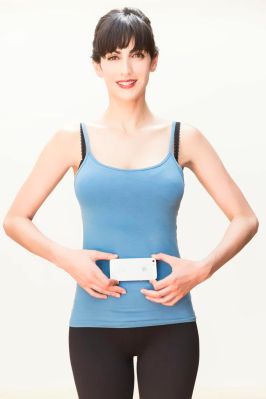ThirdLove — the first brand to come out of the longtime-stealth, well-backed MeCommerce group — entered the world with a bang earlier this year with a promise of a new app that uses smartphone data, by way of two selfie photos of the customer’s chest, to revolutionize how women buy bras. Now, after a closed beta period, ThirdLove’s iOS app is out for any and all to try it for themselves.
Buying bras can be a time-consuming, expensive and frustrating experience, and there are a number of apps and online services already out there trying to solve the problem. They include True & Co., Brayola and Sizem, among many apps from specific lingerie brands. Many of these require you to pull out the measuring tape to size yourself up, or provide information on your current bra size and your favorite brands, in order to help create a selection of bras for you.
ThirdLove is different for a number of reasons. For starters, there is the technology itself, developed by computer vision scientists. Using image recognition and human voice commands, the app takes you through the process of snapping two pictures of your chest in front of a mirror, one from the front and the other from the side (you wear a supportive bra in the pictures, with an option of a fitted tank on top of that). A user pinches and zooms to scale the pictures to match each other. Then ThirdLove processes them — my measurement took no more than a minute — and you are given a unique size, eg TL165.
If that doesn’t sound like a normal bra measurement, that’s because it isn’t. This is where the second part of ThirdLove’s unique proposition comes into play. It starts with the premise/problem that most bras today don’t fit the majority of women. And so, to really tackle the that, the company has decided to take the vertically-integrated approach: it is making its own products, which put an emphasis on “half-sizes” that will be more accurate. It’s doing so with miles of research (literally, miles travelled) to find different fabrics, hooks and other components.
Right now, ThirdLove makes its bras and other undergarments in Mexico; in future, some of that production will be moving to China. There are no plans at the moment to incorporate third-party products into the offering, although co-founder David Spector tells me that the company has already been approached by some well-known brands who would like to apply the technology to their own products. You could see a scenario where ThirdLove might even at some point take licenses to custom produce their own ThirdLove-sized garments for specific brands.
Although some competitors, like Brayola, have incorporated the concept of photos into their service, their use of them is not so much to scientifically measure your actual size, but, as Jordan noted, for more of a fun game of matching boobs to certain bras. ThirdLove’s technology, c0-founders (and, as it happens, spouses/new parents) David Spector and Heidi Zak tell me, has been in stealth for a year while they have worked on it; to protect the IP, there are patents pending on it now.
In a sense, this is a casebook example of the new wave of startups that are using technology to tackle age-old problems — other leading lights in that vein include Airbnb for travellers’ accommodation and Uber for car services. “This is about using technology from the ground up,” notes Zak. And although ThirdLove clearly has a particular consumer in mind — the adult female shopper — it’s worth remembering that this is only the first product to come from MeCommerce.
The company has so far raised a $5.6 million seed round from a list of backers that include NEA, Andreessen Horowitz, Felicis Ventures, Novel TMT, Yuri Milner, Keith Rabois and more. With that funding, and with the right traction, you can see how similar technology may get applied to a number of other categories, from head (glasses) to toe (shoes) and for other demographics like men and children.
When you consider the background of the two founders, larger and lofty goals are not so outlandish. Spector and Zak first met at MIT business school, and Zak first cut her teeth in fashion launching new businesses for the label Aeropostale before moving on to Google to working on improving some the companies’ biggest products, advertising and business solutions. Spector, meanwhile, was most recently a partner at Sequoia Capital, and has also worked for IBM and Google, where he picked up a lot of experience in e-commerce through the launch of products like Google Checkout.
“It’s really about finding new commerce models now,” Spector says of the impetus behind MeCommerce. “It’s a $300 billion/year market but the core innovations of e-commerce have not changed since 1999. Drop down menus, check-outs, waiting for your product to be delivered, and then having a loose return policy.”
Spector, and MeCommerce, however, believe that with smartphone penetration now at over 50%, and with the ability to process the data picked up by new sensors now better than ever, “all the pieces are now in place to build a really large, new kind of business in this space.”
